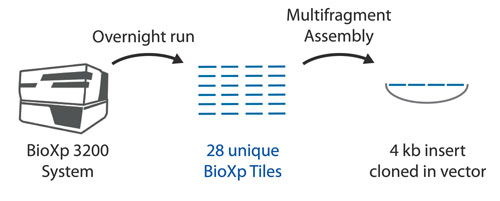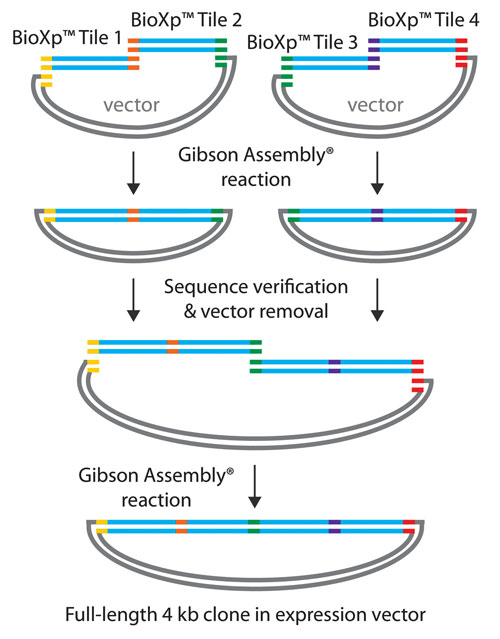June 15, 2016 (Vol. 36, No. 12)
Strategies and Tips for Assembling Large Custom-Designed DNA Constructs with BioXp Tiles
Many life scientists understand the promise of synthetic biology, but they have not applied it practically in their laboratories. SGI-DNA’s BioXp™ 3200 System (Figure 1) is capable of producing over 150 custom and unique linear dsDNA fragments (BioXp Tiles) in one work week, enabling any lab to leverage synthetic DNA. BioXp Tiles range in size from 400 bp to 1.8 kb and can be designed for a variety of downstream purposes.
Research laboratories can harness the power and capacity of the BioXp instrument to shift laboratory resources from the manual processes involved in obtaining DNA for experiments and instead focus on understanding gene function.
The purpose of this tutorial is to illustrate how any life science research lab can now easily build large DNA constructs for protein production, gene pathway analysis, building libraries, or cell engineering. While there are many possible downstream uses of BioXp Tiles, here we focus on assembling multiple Tiles into larger constructs. Included are strategies for reducing the number of clones required for the identification of error-free clones, and general tips for attaining optimal cloning efficiency following Gibson Assembly cloning of BioXp Tiles with a vector-of-choice.

Figure 1. The BioXp 3200 System generates up to 31 unique and custom BioXp Tiles starting from sequence information.
Assembling Multiple BioXp Tiles
The BioXp instrument builds up to 31 unique double-stranded DNA fragments plus one control from electronically submitted sequences. In order to enable downstream multifragment cloning of BioXp Tiles using SGI-DNA’s Gibson Assembly HiFi 1 Step or Ultra method, Tiles are designed with overlapping homologous ends. To initiate a run, BioXp users load the instrument deck with customized reagents received from SGI-DNA. Following an overnight instrument run, BioXp Tiles are ready for downstream analysis.
Let’s suppose the core facility at a research university just obtained a BioXp instrument. A lab at the university plans to use the instrument for the synthesis of a gene family, which consists of seven genes that are 4 kb long. The lab will use the instrument to build BioXp Tiles that are 1 kb subfragments of these seven genes (a total of 28 BioXp Tiles) in a single overnight BioXp run (Figure 2). Following the BioXp run, each subset of four BioXp Tiles will be cloned into an expression vector to obtain seven full-length genes-of-interest. The following sections give strategies and tips for multifragment BioXp Tile assembly in such a scenario.

Figure 2. A scenario for using the BioXp System to build BioXp Tiles. In this example, 28 BioXp Tiles, all 1 kb long, are assembled in an overnight run. This tutorial discusses strategies for assembling four BioXp Tiles in a 4 kb construct in an expression vector for downstream analysis.
Direct Assembly Using Gibson Assembly® Cloning
There are many strategies for assembling multiple tiles into a single larger construct. A first thought might be to simply set up a Gibson Assembly HiFi 1 Step or Ultra reaction for each set of four Tiles along with an expression vector-of-choice. While this strategy may seem the simplest and most straightforward, it’s important to recognize that this scenario is the most challenging and may require screening many clones to identify an error-free clone. For this scenario, it is best to maximize the efficiency and optimization of the Gibson Assembly reaction by normalizing the purity and quantity of the DNA fragments prior to the assembly reaction, and transform with high efficiency competent cells, as detailed in the Tips for Assembly.
Direct Linear Assembly
A modification of the direct assembly approach is to assemble the BioXp Tiles as a linear fragment (in the absence of vector), and then PCR-amplify the resultant 4 kb fragment with a high-fidelity DNA polymerase. Gel purifying the 4 kb amplicon prior to assembly with a vector-of-choice will likely improve the cloning efficiency of the reaction.
Multistage, Multifragment Assembly
An alternate multifragment assembly strategy both reduces the number of colonies required for error-free clone screening and increases cloning efficiency of the assembly reaction by cloning in two stages. This strategy, 2 × 2 Gibson Assembly (assembling two of the four fragments first before the final assembly reaction), is an ideal starting point for new users of the BioXp instrument and is especially suited for laboratories where colony screening is not automated or routine.
2 x 2 Gibson Assembly Strategy
The steps of the 2 × 2 Gibson Assembly Strategy are outlined in Figure 3. First, BioXp Tiles are gel-purified and normalized. Instead of assembling all four Tiles simultaneously with a vector for each reaction, Tiles are subgrouped into groups of two for subcloning and sequence verification. Each 2 kb error-free clone is then removed from the subcloning vector via PCR amplification or restriction digestion. These fragments are assembled into a 4 kb fragment in the final destination vector. As Gibson Assembly is seamless, only a few colonies likely need to be picked to confirm an accurate sequence.

Figure 3. Overview of the 2 × 2 Assembly Strategy. BioXp Tiles are designed and built with overlapping ends (depicted in yellow, orange, green, purple, and red) for streamlined Gibson Assembly cloning. For 2 × 2 Assembly, two linear 1 kb Tiles are assembled in separate reactions. The 2 kb intermediate constructs are sequence-verified prior to final assembly.
Tips for Assembly
For optimal results with any of the strategies outlined in this tutorial, use the following best practices when assembling BioXp Tiles with the Gibson Assembly HiFi 1 Step or Ultra kit:
- Prior to assembly, check the concentration and purity of BioXp Tiles by gel analysis.
- Gel purify DNA fragments for higher cloning efficiencies. This is important if there are shorter off-target products in the sample.
- Add fragments to the assembly reaction such that their relative concentrations are roughly equal.
- If the Tile concentration is low and purity is high, concentrate the Tiles or mixtures of like-sized fragments using a PCR spin column.
- When using similarly sized DNA fragments, it is simple to streamline gel purification. Adjust the relative concentration of each BioXp Tile based on the intensity of the band. Pool Tiles in a single tube so that the final mixture has an approximately equal concentration of each Tile. Run the mixture on a gel in a single lane and perform gel purification of the mixed Tile band prior to assembly.
- We recommend the use of TransforMax™ EPI300™ Electrocompetent E. coli for transformation of the Gibson Assembly reaction mixture to increase the colony count approximately 10-fold.
Conclusions
The BioXp System delivers BioXp Tiles up to 1.8 kb long. Many methodologies are available for assembling these Tiles into much longer gene fragments. In this tutorial, we have introduced a few tips and strategies toward successful downstream assembly reactions of BioXp Tiles using Gibson Assembly cloning. More cloning and experimental design strategies are possible. Whatever strategy is used, BioXp Tiles are potential building blocks for a multitude of gene studies and can ultimately be assembled into larger DNA elements, genes, and on a much larger scale, synthetic genomes.
Katie Lyons ([email protected]) is a scientist at Synthetic Genomics.
Gibson Assembly® is a registered trademark and BioXp™ is a trademark of Synthetic Genomics, Inc. Gibson Assembly® US Patent Nos. 7,776,532, 8,435,736, and 8,968,999. TransforMax™ and EPI300™ are trademarks of Epicentre Technologies Corporation.



